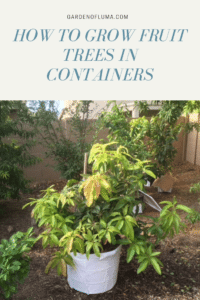Growing Fruit Trees in Containers in Hot Climates

There is nothing better than eating fruit off your backyard fruit tree, but in an urban backyard you are limited on space. When I first started gardening I had no idea that you could grow fruit trees in containers. When I think of a tree, I think of something large and majestic. I’ve since learned a lot about growing fruit trees in containers in this hot climate.
Can you grow a fruit tree in a container? The answer is absolutely! If you select the right kind of fruit trees for containers, you CAN enjoy fruit from them. Growing fruit trees in a container in hot climates does take a little more effort, but you can harvest enough fruit for your needs. Let’s take a look at how to grow a fruit tree in a container.
Why grow a Fruit Tree in a Container
Growing fruit trees in containers has some advantages.
I grow tropical fruit trees in containers so I can move them into the garage or a protected place when faced with threats of frost during those chilly winter nights.
I’m on a measly 1/5th of an acre lot, so I don’t have a ton of space for large fruit trees. Growing some of my fruit trees in containers allows me to maximize my space and get more variety.
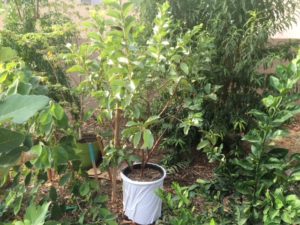
Container Size
I typically recommend planting in a container the next size up from what it was purchased in at the nursery.
So let’s say you bought a tree in a 7 gallon container, I would then re-pot it in a 15 gallon container at home.
I think many people have the idea of putting the tree in a really large container, so it can grow into it’s pot. While this seems more convenient it could potentially kill your fruit tree.
What I’ve found, when placed in a pot that is too large, the soil will hold too much moisture on the bottom and outer layers of the container.
Since the tree doesn’t have a large root system that fills much of the soil and container, the excess water retention will lead to root rot and fungal issues.
Fruit trees do not like to be sitting in water or have wet feet, especially in cooler soil temps.
Some fruit trees that are less susceptible and like being constantly moist, like a Jaboticaba, can take being placed directly in a large pot without issues.
I still wonder though if the small root ball is getting the water it needs or if the water is washing to the sides and bottom of the container.
Watering in Containers
Like one would think, you have to water much more frequently in a container than in the ground. Since the pot is more exposed to the warm air, it’ll dry out quicker.
It does depend on a few different factors like size of the fruit tree, air temps, soil type, sun exposure, and container type.
Some of my fruit trees during the hottest parts of the year are watered daily, while others can go a few days without watering.
It’s important to make sure that the pot is thoroughly watered. Sometimes it seems like you have watered enough, but if you stick your finger in the top layer of the soil it still feels dry.
What I’ve been taught is water by the amount of gallons a container size is, in other words 15 gallons of water for a 15 gallon container.
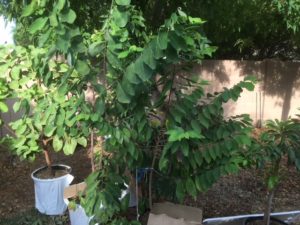
Container Type
There are a few different types of container materials that are used for fruit tree containers. Each material has its pros and cons, so it just depends on what works for your needs.
-
- Ceramic tends to be more aesthetically pleasing for the yard. There are some beautiful ceramic pots, but does come with a heftier price tag and can chip and break. Ceramic however, keeps roots cooler in the hot months and warmer in the cool months.
-
- Terra Cotta is another heavy material made from clay. Terra Cotta is very porous and can wick the water away from the roots, causing a need to water more frequently. Salts can eventually build up in the terra cotta causing salt stains.
-
- Plastic is my go to container for fruit trees. I like plastic because it’s cheap and light weight. Many of my container grown fruit trees are tropical and need to be moved to a warmer location during our cold snaps. Fruit trees in containers are extremely heavy, adding a wood or clay pot adds even more weight. Plastic containers also seem to retain enough moisture. Some negatives with plastic is that the roots will start swirling around the containers if left in a container that is too small for too long. It is important to periodically root prune or up the size of your pot when the tree is ready. Also, the plastic containers tend to heat up.
-
- Wood half barrels are commonly used for growing fruit trees. Wood barrels have a nice rustic look, but they are extremely heavy. It is difficult to get the tree out of a wood barrel if you need to pot in something larger or prune the roots. Wood planters are more expensive than plastic containers and can deteriorate over time.
- Fabric is another popular option. Fabric pots tend to be great for producing really healthy fibrous root systems that are great for the tree to absorb nutrients.The cost isn’t too bad as you can generally by these in a 5 pack deal. The roots are naturally pruned through air pruning and don’t swirl around like in a plastic container. The major drawback I have with fabric pots is watering. In our hot, dry summer where the temps are routinely over 105 degrees, it would be too much to have to water them several times a day.
Heat Tolerance and Sun Exposure
Container growing in hot climates can get a bad rap. I hear a lot of gardeners in my area advise against growing in containers, saying that the heat will kill the tree.
Obviously, if you leave a black nursery pot out in our blazing hot sun all day, it’s going to cause problems for the tree or kill it.
I use a white kitchen shelf liner to wrap around my black pots to prevent them from absorbing all that excess heat from the sun.
I like the wraps because I can remove them in the winter when I want the pots to maintain as much warmth as possible.
I utilize various things to shade the pots, like cardboard. I’ve had fruit trees that have lived several years through 120 degree summers, so if you create the right micro climate, the heat won’t kill the tree.
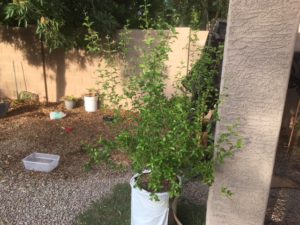
Soil for Containers
Drainage is absolutely critical in growing fruit trees in containers. You don’t want to fill a container with native clay soil or even potting soil, because it retains too much moisture.
I use a local cactus soil mix that contains things like lava sand to improve drainage, but still retains enough water.
Feeding In Containers
Fruit trees need to be consistently fed, since it takes a lot of energy to produce the fruits that we love. A well fed tree is going to be healthier and able to withstand things like pests or weather conditions.
It’s like a healthy human – less likely to get sick and better able to fight off disease. Since fruit trees in containers don’t have access to things that their in-ground counterparts have in the soil, one must be more regimented with a feeding schedule.
Also, fertilizer tend to wash off the tops of the containers or drain through the containers quickly. I feed my fruit trees in containers twice per week in the growing months with fish emulsion and liquid seaweed per instructions on the labels.
I also top with some compost and mulch a few times a year. I use a foliar spray every 2-4 weeks which is a mix of liquid seaweed, chelated iron, and sometimes neem oil.
Here are the products that I use and recommend.
Pruning
Pruning is a big deal when growing fruit trees in containers. Keeping the fruit trees pruned at a manageable size will help slow down the root system.
It is typically necessary to remove the tree from the pot and cut about a third of the roots off the sides and bottom to keep the tree from becoming root bound.
When pruning the roots, you’ll also have to prune the top off the tree to balance the growth. If the roots continue to circle around the pot it can basically strangle the tree.
So its important to cut through circling roots. It’s best to prune when dormant, but you can prune other times of the year as needed.
After fruiting tends to be a good time, since all the energy that was going into producing fruit will go into vegetative growth when the fruit is gone.
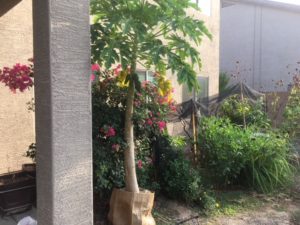
Fruit Trees that Grow well in Containers in Hot Climates
Any fruit tree that is a slow grower or on dwarf rootstocks are good to look at for container growing.
This is a list of what I’m currently growing in containers:
-
- Meyer Lemon– Citrus in general tends to do pretty well in containers. Getting dwarfing rootstocks will help. Citrus likes to somewhat dry out in between watering and tend to be heavy feeders.
-
- Tropical Guava– This is one of the easiest tropical fruit trees to grow in a container. Guavas grow rapidly and fruit quickly. Check out my in depth post on growing guava in hot, dry climates.
-
- Fig– I’m growing a Black Mission Fig in a container, but there are better suited varieties for containers like Violette de Bordeaux. Figs root systems grow pretty rapidly, so this is definitely a fruit tree that will need to be root pruned consistently to maintain in a large container. You’ll know when the roots fill the container because it’ll need water more frequently. Fig leaves droop when needing water. I get a couple crops of figs off my container tree.
-
- Mango-There are several dwarf varieties like Pickering, Irwin, Fairchild, Ice Cream, Nam Doc Mai that are suited better for container growing. I’m growing a Carrie variety in a container and the mangos are excellent tasting.
-
- Atemoya– This is a hybrid of Sugar Apple and Cherimoya. Atemoya is a shallow rooted tree which makes it good for containers. I’m growing a seedling from African Pride Atemoya. Its unclear what the fruit will be like having grown from seed.
-
- Sugar Apple– Also known as Annona Squamosa is similar to the Atemoya and other members of the Annona family which are suited well for container culture. I’m growing an unknown seedling variety from a fruit I ate. Sugar Apple are often grown from seed.
-
- Jaboticaba– This is a slow growing tree that fairs well in containers. There are a few different types of Jaboticaba. The blue is the more common variety. I’m growing a red hybrid variety from seed. It can take Jaboticaba several years to fruit.
-
- Canistel– Also known as Yellow Sapote or egg fruit, this is more of an experimental tree for me. I’m growing a seedling variety from Hawaii that is more pointed in shape.
-
- Barbados Cherry (Acerola)- It produces cherry looking fruits with one of the highest levels of vitamin c in any food. The tree grows more like a small shrub and adapts well to containers.
-
- Papaya- If you get a dwarf variety, Papaya can grow and fruit in containers. I have a Tainung variety. Check out my post on growing papaya in hot, dry climates for more info on growing papaya.
-
- Sapodilla- This is another really slow growing tropical fruit tree that does well in containers. Check out my post on growing sapodilla in hot, dry climates for more info on growing sapodilla.
- Soursop– Another member of the Annona family and is the most tropical of the Annona’s. Check out my post on growing soursop in hot, dry climates for more info on growing soursop.
Some others to consider-Pomegranate, Dwarf Mulberry, Dwarf Peach, Dwarf Apple, Starfruit, Longan
Final Thoughts
Not only is growing fruit trees in containers in hot climates doable, but a great way to grow fruit in a limited backyard space.
You will be able to have several fruit trees in an area where you may have only been able to plant one variety in the ground.
I encourage you to give container growing a shot, you won’t be disappointed.
Please comment below on anything that you enjoyed from this post or any experiences with growing fruit trees in containers.

